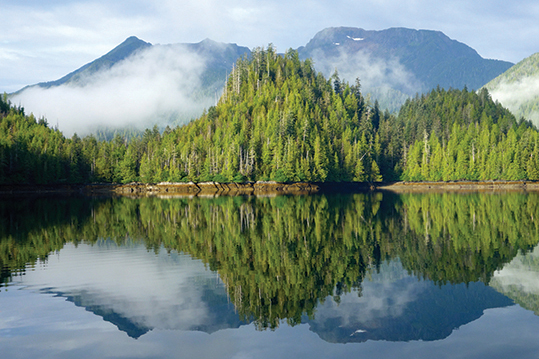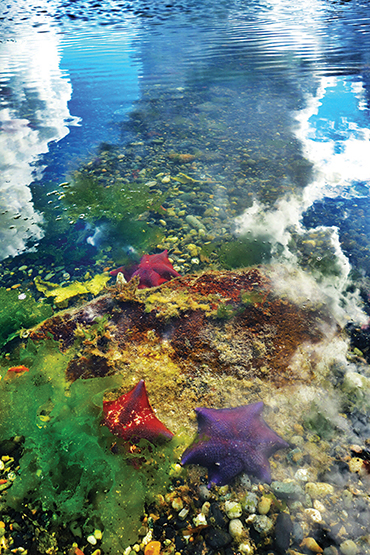Exploring the amazing history and wildlife of this off the beaten track British Columbian isle (published February 2014)
“That bubble is swimming,” I say, gesturing with my paddle.
My mother ignores me and paddles closer, peering into the water at the predatory sea slug swimming underneath the hull of my kayak. We’ve seen the hooded nudibranch in our guidebook, and I watch the gelatinous tubular body, approximately the length of my hand, as it wiggles in the brackish water. My mother leans over to snap a photo, her life jacket giving her a double chin.
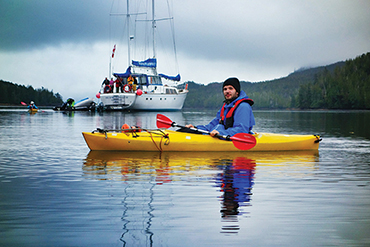 We turn to paddle our kayaks back to Island Roamer, a 68-foot ketch operated by a Canadian company called Bluewater Adventures. A sharp wind tugs at my hair and I shiver happily, zipping my Gore-Tex jacket high underneath my chin. The mid-August sun shines brightly, but I’m wearing knee-high rubber boots and three synthetic shirts.
We turn to paddle our kayaks back to Island Roamer, a 68-foot ketch operated by a Canadian company called Bluewater Adventures. A sharp wind tugs at my hair and I shiver happily, zipping my Gore-Tex jacket high underneath my chin. The mid-August sun shines brightly, but I’m wearing knee-high rubber boots and three synthetic shirts.
Cold, jagged rocks line the shore, where we see trees the size of skyscrapers growing on soft carpets of moss. We are 130 kilometers west of mainland British Columbia in the archipelago of Haida Gwaii, known until 2010 as the Queen Charlotte Islands, and the water beneath us is the bone-chilling Pacific Ocean, pulsing with life.
Often called the Galapagos of the north, Haida Gwaii refers to two large islands—Graham Island in the north and Moresby Island in the south—and more than 150 smaller atolls, which together form a landmass of over 10,000 square kilometers. North from the archipelago is Alaska; south is Vancouver Island. To the east is Hecate Strait and then mainland Canada, and to the west is the open Pacific.
The price of visiting a place so remote is the time it takes to get there: all visitors arrive either by water or—as our group did—by air, landing at the remote airport in the tiny town of Sandspit on the northwest tip of Moresby Island. After a night at the Sandspit Inn, we hopped a 1970s-era bus to the Haida Heritage Center for an orientation of the land, the people, and the ecosystem, which somehow, even to a visitor, feel inextricably linked.
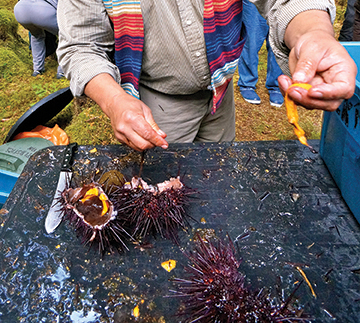
The Haida people are loosely related to the neighboring Tlingit and Tsimshian cultures, though they evolved on the islands in relative isolation. For thousands of years, they had such plentiful food sources, including salmon, halibut, cod, shellfish, seaweed, berries and nettles, that they were able to devote a large portion of their time to artistic, ceremonial and architectural pursuits. Their seamanship, strength and ferocity are renowned, and legends tell of their ancient conquests reaching as far south as Mexico in hand-carved cedar canoes.
After a traditional lunch of smoked salmon, nettle-mint tea, and dehydrated halibut roe on seaweed, we re-boarded the bus to Moresby Camp. I did the math: it had taken more than 36 hours to travel from Seattle to the inlet where the Roamer was moored. I am used to remote places, but it was then that I began to sense that Haida Gwaii is different. Rugged. Primal.
Our crew was four windburned, smiling people: captain, first mate, naturalist and cook. The yacht was designed for efficiency with a well-equipped galley, eight double-occupancy cabins, three heads (each with a hot shower), and a comfortable salon with a small library of coffee-table tomes and local guidebooks.
WILDLIFE ABOUNDS
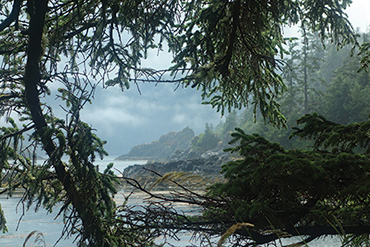 The crew oriented us to the ship, put hot coffee in our hands, and turned the boat south. The naturalist gestured to a stack of binoculars she’d set out for our use, and by the end of the first afternoon we had spent more than an hour with a local pod of orcas, including a mother and her ketchup-colored newborn. As we listened to the whales clicking and chirping through the underwater microphones, I had the unshakable feeling that they were watching us, too.
The crew oriented us to the ship, put hot coffee in our hands, and turned the boat south. The naturalist gestured to a stack of binoculars she’d set out for our use, and by the end of the first afternoon we had spent more than an hour with a local pod of orcas, including a mother and her ketchup-colored newborn. As we listened to the whales clicking and chirping through the underwater microphones, I had the unshakable feeling that they were watching us, too.
That night, after slabs of fresh fish and hearty glasses of Argentinian wine, the captain spread a chart across the table and pointed to landmarks. We would explore the leeward side of the archipelago, staying on the sheltered east coast of Gwaii Haanas National Park Reserve and Haida Heritage Site. We would see whales and other sea life, explore the abandoned sites of thousand-year-old villages, and breathe in the wild, open sky.
And wild it was. Each day we explored a new coastline, shuttled from the Roamer to the shore in Zodiacs. Wearing waterproof pants and knee-high rubber boots, we wandered the forests, waded through estuaries and admired scuttling crabs in tidal pools. We paddled kayaks along the shore, pointing out bold black-tailed deer and furtive raccoons with paws like human hands. We counted sea birds—puffins, ravens, gulls, auklets, petrels—and imagined that we heard the deep-throated growl of the Haida Gwaii black bear. One evening, watching the bioluminescence shimmering in the ink-black bay, I stripped to my swimsuit, slid into the water, and moved through the ocean with tiny specks of light clinging to my skin.
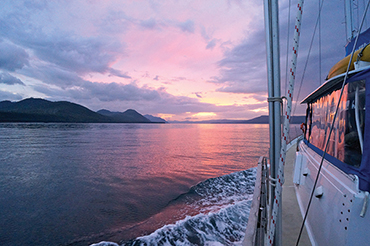 The water was constantly changing. It was blue and green and purple and gray, with jellyfish and barnacles and halibut and sea stars. We soon had photos of humpbacks, fin whales, harbor seals and Steller sea lions. When we kayaked, we hunched over as we paddled so that we could peer into the depths. When we rode the Zodiacs to shore, we skimmed our hands in the water for the pleasure-pain of feeling fingers slowly go numb.
The water was constantly changing. It was blue and green and purple and gray, with jellyfish and barnacles and halibut and sea stars. We soon had photos of humpbacks, fin whales, harbor seals and Steller sea lions. When we kayaked, we hunched over as we paddled so that we could peer into the depths. When we rode the Zodiacs to shore, we skimmed our hands in the water for the pleasure-pain of feeling fingers slowly go numb.
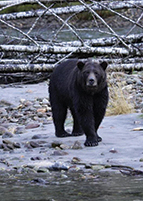
A RICH HISTORY
In every place where there had been an ancient village—including Skedans, Ninstints and Tanu, we were greeted by a friendly Haida as we came on shore. The watchmen, as they are called, are part of a program that has been in place in Haida Gwaii for more than thirty years. Concerned about vandalism in abandoned villages, volunteers anchored their own boats around the tiny islands to stand guard for the summer season. The program is now government-funded, and Haida men and women volunteer for month-long stints in tiny weather-worn cabins so they can greet visitors, tell stories, and protect the bones of their ancestors.
They share practical information, too, like the middle-aged woman at Hot Springs Island. “There was an earthquake last year,” she told us. “More than 7.7. It dried up the springs.”
I was crushed. Hearing legends of naturally occurring warm pools that would seat a dozen people, I had been looking forward to a hot soak for days. “There’s one small pool down by the beach,” she said. “The water is starting to come back, and we’ve built up the rocks so that one or two people can soak.” We handed her the baked goods we’d brought from the boat, and she winked at us. “Come on,” she gestured. “I’ll show you.”
The main duty of the watchmen, though, is to set a tone of reverence in a place where the sacred could easily be overlooked. Wander into any woods and you are likely to stumble across hidden murmurs of the Haida’s rich past: moss-covered canoes, live cedars with strips of bark removed (called “culturally modified trees,” or CMTs), and middens (heaps of discarded shells and other waste that mark an inhabited village site). Most famous, though, are the totem poles.
The Haida’s carved wooden pillars serve four distinct purposes: there are memorial poles, mortuary poles, house frontal poles and interior poles. Designed to be erected and then eventually decay, the carved poles are left—as they have been for thousands of years—to return to the soil of their birth.
A UNIQUE CELEBRATION
Not all the poles are decaying, though. Midway through our trip, we joined more than 200 people at Windy Bay, a cove on Lyell Island, to see the raising of the Gwaii Haanas Legacy Pole, a 13-meter monument commissioned to celebrate the 20th anniversary of a co-management agreement between the government of Canada and the Haida Nation. It is the only place in the world, they say, that is protected from seafloor to mountaintop.
The ceremony marked the raising of the first monumental pole in over 130 years, and the excitement was palpable. I joined the visitors arriving by sailboat, canoe, floatplane and motor yacht, wading across the uneven rocks to shore. As I moved through the crowd gathered around the watchman’s cabin to catch a glimpse of the horizontal pole, a wrinkled Haida woman handed me a steaming Styrofoam cup of halibut chowder. Several hundred people were gathered in the clearing and I was suddenly acutely aware of my own pale skin. Broadly speaking, white people have not been good to the Haida.
But there was no doubt: we were welcome. A jolly-looking Haida man reached under a folding table to a Rubbermaid bin full of salt water, pulled out a live sea urchin and slammed his cleaver between the spines. Grinning, he handed me a strip of meat and gestured for me to eat: sea urchin gonads, the ceremonial delicacy. I grinned, chewing something that tasted like sour butter and brine.
Speeches were delivered in three languages—Haida, English, and French—into a halting PA system. In the center of the clearing, the pole rested horizontally. Crafted of solid wood, the carvings show stacked figures: raven, grizzly bear, sculpin and sea wolf. One figure shows Sacred-One-Standing-and-Moving, the supernatural Haida being who is said to steady the land against earthquakes. Another carving shows five faces with large dark eyes, representing the brave protesters who stood together against logging at Lyell Island in 1985. The top of the pole is an eagle, gleaming with copper that was cut by hand.
“We thank you for coming to join us today,” a Haida elder said. Old women and young girls walked in silent circles around the pole, watched by hundreds of quiet eyes, as they sprinkled water and spread soft white eagle down across the wood. “If you’re willing, please find a place on one of the ropes. If you’d rather stand back, then we thank you for coming to bear witness.”
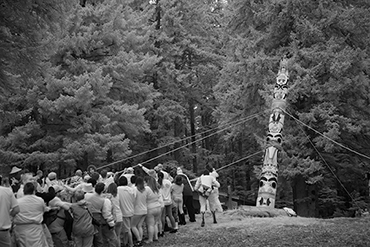 The crowd moved into action, hundreds of hands finding places on the six ropes that trailed from the top of the pole. At the call, the people pulled. The pole’s base slid into the deep hole that had been prepared, and the eagle rose steadily into the sky. Somebody called for a level, and tiny adjustments were made by adjusting the pressure on each rope. Then the rope teams held steady as eager hands shoveled rock and dirt around the wooden base, holding the monument in place. There were no machines used in raising the 3,000-kilogram legacy pole.
The crowd moved into action, hundreds of hands finding places on the six ropes that trailed from the top of the pole. At the call, the people pulled. The pole’s base slid into the deep hole that had been prepared, and the eagle rose steadily into the sky. Somebody called for a level, and tiny adjustments were made by adjusting the pressure on each rope. Then the rope teams held steady as eager hands shoveled rock and dirt around the wooden base, holding the monument in place. There were no machines used in raising the 3,000-kilogram legacy pole.
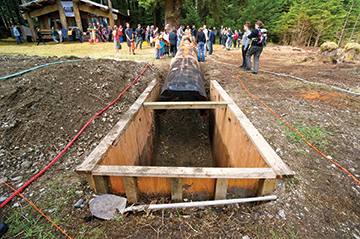 When the pole was secure, the throngs disbanded without ceremony. There were hugs exchanged, quick tears on tan faces, small children tossed from family to friends. Cameras were secured, life jackets untangled.
When the pole was secure, the throngs disbanded without ceremony. There were hugs exchanged, quick tears on tan faces, small children tossed from family to friends. Cameras were secured, life jackets untangled.
As we loaded the Zodiac and slowly moved away from the shore, I looked back toward the pole, visible through the trees. I thought about the orcas we’d seen that morning, which seemed to be leading us toward the gathering. I thought about the people who traveled the coast for thousands of years in hand-carved cedar canoes. I thought about what it means to bear witness, and what it means for a place to be wild and true.
Then we were clambering back onto the Roamer, thawing our fingers around mugs of hot tea and waiting for the wind to rise in our sails. We turned into the sun, and I looked at the lines on my mother’s hands as she smoothed the chart across the table to plan the rest of our journey. She glanced up at me and smiled, then we turned together to look back at Windy Bay. The clearing around the watchman’s cabin was hidden in the forest, but as I took my mother’s hand, I thought I could see the glint of copper through the trees.
Charlotte Austin is a writer and adventurer living in Seattle, WA. In the past year, she has guided in the Himalaya, acted as writer-in-residence in a National Forest, and edited an anthology called The Better Bombshell: Writers and Artists Redefine the Female Role Model. She is a Wilderness-EMT, an Extra Class Ham Radio operator, and aspiring offshore sailor.
If You Go: Notes From The Captain
For more than 15 years, Captain Neil Shearar has been running charters in British Columbia, Alaska, and around the globe. He is an examiner in the North American Yachtmaster Training program, a senior bear-viewing guide, and a Transport Canada Certified Master.
To travel within the Gwaii Haanas National Park, you are required to carry a permit and hear an orientation. For years, the only place to hear the orientation was in Skidegate, which can be inconvenient for cruisers coming from the south. Recently, however, Parks Canada has been taking new measures to accommodate visitors from the south. As you plan your visit, it’s worth calling to see if there are any new procedures in place.
When you go ashore to meet the watchmen, be respectful. Small gifts—chocolates, tea, coffee, baked goods, magazines—are appreciated, because these people are living in a very remote place. Let them set the tone of the interaction. If they feel comfortable, they’re very welcoming as hosts, and are keen to share their knowledge and culture with guests.
There are several important radio channels. The park wardens monitor channel 16, and the watchmen monitor channel 6. The Prince Rupert Coast Guard is on channel 83A, and they’re often kind enough to read you the weather forecast if you can’t hear it clearly on your own.
If I were planning a personal trip, I’d want at least ten days in Haida Gwaii. The watchmen sites are manned June through September, but the weather is best in August.
There are only two places to get water: Louscoone Inlet (near Skungwai) and Shuttle Island (near Hoya Pass.) All drinking water should be treated. I recommend bleach and charcoal filters.
Kelp is your best friend. As the summer season progresses, kelp grows on almost every obstruction in the water, like rocks and reefs. Stay on the lookout, and pay close attention to anything that looks like a patch of seaweed.
There are lots of great resources available. I recommend Exploring the North Coast of British Columbia, by Don Douglass. I also use the Marine Canada website, which has a printable map that shows the locations of all the weather buoys and telemetry reporting systems. It’s worth understanding how that system works if you’re going to be traveling in Haida Gwaii.
The absolute must-see places are Skedans, Tanu, Windy Bay, Hot Springs Island, and Skungwai. Cape Saint James is spectacular, if the weather permits. And if you can time it right, try to snorkel during a low tide in Burnaby Narrows to see the incredible intertidal diversity. Be aware that sailing through Burnaby Narrows can be harrowing. Personally, I sail around Burnaby Island.
You can’t visit a place like Haida Gwaii without feeling that you’re sailing into something mystical. There are endless opportunities for exploration, the marine wildlife is exceptional, and it’s always an adventure, but there’s something bigger in Haida Gwaii, too. You truly are sailing into the mist.
For more information visit www.charlotteaustin.com.

















